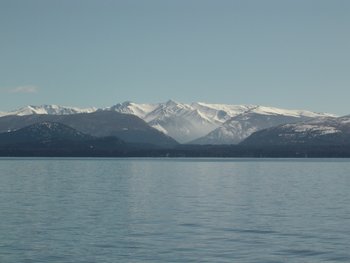San Carlos de Bariloche
|
|
San Carlos de Bariloche in Argentina is situated on the foothills of the Andes, surrounded by lakes (Nahuel Huapi, Gutiérrez Lake, Moreno Lake and Mascardi Lake) and mountains (Tronador, Cerro Catedral, Cerro López). It is famous for skiing but also great for walking and climbing. Cerro Catedral is one of the most important ski centers in South America.
At the crest of the Andes, with an elevation of over 3000 meters, vegetation is thin and snow almost never disappears. Going eastwards down the slope from Samoré Pass, the road passes through dense yet fairly dry forests which lack the immense rainfall of the woodlands of Chile due to the rain shadow effect, travelling along the shore of Nahuel Huapi. As we move eastwards, the humidity diminishes until the Limay river, where the dry Pampas begin.
You can get to Chile by two ways; across the Andes to Puerto Montt via 4 buses and 3 boats, or via the Samoré International Pass to Osorno.
The name Bariloche comes from the Mapuche word Vuriloche meaning "people from behind the mountain" (furi = behind, che = people). The Vuriloche pass was used by the Mapuches to cross the Andes and was kept secret from the Europeans priests for a long time.
Settled primarily by Austrians and Germans about 1895, San Carlos de Bariloche has the appearance of an alpine town. Population (1991) 77,600.
Bariloche was officially founded on 3rd. May, 1902, by a decree of the Executive Branch of the National Government. In 1909 there were 1,250 inhabitants, telegraph, post office, and a road connecting the city with Neuquén. Commerce, however, continued to depend from Chile until the arrival of the railroad in 1934.
Between 1935 and 1940, the Directorate of National Parks carried over a number of urbanistic works, giving the city a characteristic beauty. Among them: the Civic Center (home of a Library, a Theatre, a Museum, the City Hall, the Post Office, the Police Station and the Customs), the Cathedral, Llao Llao Hotel, and others.
Tourism, both national and international, is the main economical activity of Bariloche, all year around. The main ski station is the one at Cerro Catedral. During the summer, beautiful beaches such as Playa Bonita and Villa Tacul welcome sun-bathers and some brave lake swimmers (the waters, from melting snow, are always very cold). The fishing season is another great attraction. Bariloche is the biggest city of a huge Lakes District, and serves as a base for many excursions in the region. Trekking in the mountains, almost completly wild and uninhabited, is also a populat activity.
Besides tourism and the many activities and services associated with it, Bariloche is home of first class scientific and technological activities. The Centro Atómico Bariloche is a research center of the National Atomic Energy Comission, where basic and applied research in many areas of the physical sciences is carried over. One of its departments is the Instituto Balseiro, a higher education institution with a small and carefully selected number of students, that grants degrees in Physics, Nuclear and Mechanical Engineering, and Masters and Doctorate degrees in Physics and in Engineering. The city also hosts INVAP, a high technology company that designs and builds nuclear reactors and space satellites, among other projects. In addition, there are also several departments and laboratories of the Comahue University.
The city has an modern airport equipped to receive any kind of aircraft. Several of the most important airlines of Argentina maintain regular flights to Bariloche, as well as some international lines from neighboring countries, especially during the ski season.
External links
- www.bariloche.org
- www.bariloche.com.ar
- www.onlinehoteles.com/bariloche (http://www.onlinehoteles.com/bariloche.htm)af:Bariloche

